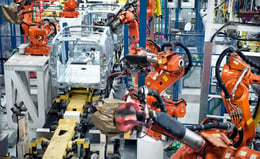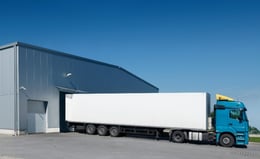Industry 4.0 and Supply Chain Integration
Brian Hoey - December 22, 2020

 From an integration perspective, the modern supply chain is at something of a crossroads. On the one hand, we’re starting to see the ways in which integration can really add value for businesses up and down the supply stream—to wit, a recent study found that inventory planners that switched from pen-and-ink planning to more integrated systems were able to improve their productivity by 25%. On the other hand, not everyone is prioritizing integration in a serious way—see: the 21% of manufacturers who still send information via fax.
From an integration perspective, the modern supply chain is at something of a crossroads. On the one hand, we’re starting to see the ways in which integration can really add value for businesses up and down the supply stream—to wit, a recent study found that inventory planners that switched from pen-and-ink planning to more integrated systems were able to improve their productivity by 25%. On the other hand, not everyone is prioritizing integration in a serious way—see: the 21% of manufacturers who still send information via fax.
This disparity in the current integration landscape gives savvy supply chain managers a chance to gain a real competitive advantage simply by transition to more cohesive and fully integrated systems. At the same time, those same cohesive and fully-integrated processes can also be important stepping stones on the road to digital transformation, Industry 4.0 adoption, and the creation of a smart supply chain. In fact, we’d go so far as to say that robust, end-to-end integration is a prerequisite for a successful digital transformation.
Key Statistics
To get a better sense of what we mean we talk about the importance of integration for Industry 4.0-readiness, here are a few more statistics:
- Fully integrated companies outpace their competitors by 20%, in part because increased connectivity can help speed up decision-making.
- 60% of manufacturers have difficulty sharing information between departments.
- IIoT (industrial internet of things) deployments—which require robust technology integration in order to provide insights—can help boost productivity by 30%.
- 69% of decision-makers think industrial analytics will become increasingly key to success over the next 5 years.
All of which is to say that those who don’t integrate are leaving value on the table, and they may be slowing their ability to remain competitive in the Industry 4.0 era.
How Supply Chain Integration Powers Industry 4.0
Let’s imagine two different factories: In the first one, the warehouse, the factory floor, and loading dock are all cordoned off, and each one has a separate set of non-overlapping personnel, servers, and technology solutions. As a sales planner, you want to figure out what your production capacity actually is, so that you know whether or not it’s sufficient to meet expected demand—which means that you need to have at least three separate conversations with three different functional teams who might have completely different ideas of what’s going on across the production chain. You come away from these meetings with at best a set of hypotheticals: If your inventory levels were increased, maybe you’d be able to increase throughput. Maybe you could leverage dock-to-dock workflows to speed up fulfillment of certain orders. But there’s likely to be fairly little that you can say for certain—meaning you won’t be able to optimally match demand and capacity.
Now, imagine the same factory, but without the divisions. Every touchpoint can see and access every other touchpoint, there are cross-functional teams, and they share a common IT infrastructure (perhaps with different solutions that all internetwork in a postmodern ERP architecture). Here, you ask you questions about capacity, and you get a much clearer picture, because inventory and production are already sharing data, and they both have visibility into logistics. When you pose a theoretical process improvement for temporarily upping capacity (without taking on extra capital commitments), the suggestion can be analyzed end-to-end and given a reasonable assessment. All of a sudden, because there was data integration throughout your production chain, you were able to gain real visibility into your capacity and make smarter operational plans.
Of course, end-to-end visibility is just step one. In this integrated environment, you also have a much larger repository of data to work with. That means that if you integrate advanced analytics software into your IT stack you can gain radically more value by generating potential process improvements and smarter, more accurate forecasts. Because of the decentralized nature of that stack, you can begin to contemplate cloud deployments (which are key features of most Industry 4.0 adoptions). By the same token, this initial breakdown of silos can pave the way for further integration, e.g. of something like IIoT devices that can improve uptime and provide even more valuable data. In this way, you’ve already laid the groundwork for the AI-driven cyber-physical systems of the Industry 4.0 era.
How to Assess (and Improve) Your Integration Levels
Okay, we’ve seen how creating an integrated process that connects data and planning from multiple touchpoints can create a highly-visible IT environment that’s primed for Industry 4.0 improvements. If we extend that logic beyond the walls of the production plant to include integration with suppliers, logistics partners, and even customers, it’s possible to envision an even more robust and cohesive data-driven supply chain. But all of this leaves us with an important question: how can you figure out your current level of integration with an eye towards improvement?
For starters, there are a few metrics that you can look at:
Total Gigabytes of Data
Wherever the bulk of your data resides—whether that’s in an ERP system, a TMS, an S&OP solution, or something similar—you’ll want to figure out just how much data there is. This is an imperfect measure, of course, but if that number is large or growing it’s a decent indication that you’re at least successfully achieving some level of data integration.
Forecast Accuracy
Whether you’re using pen and paper (not recommended, but still not uncommon) or a digital forecasting solution in whatever area you select, your forecasts should get more accurate the more successfully you integrate information from other touchpoints. This isn’t to say that you’ll always be able to expect the unexpected, but if you think that your supply chain is integrated but your production forecasts are always way off, you may need to reconsider.
OOE
Overall operational efficiency is used to measure any number of different things, but the fact remains that a more integrated production plant, warehouse, transport network, etc. should function more efficiently. If this number improves as your integration efforts move forward, you’re probably on the right track. If not, you may have some work to do.
Of course, no transformation happens overnight. But by focusing on integration now, you can pave the way for future success in an increasingly digitized global supply chain.
LATEST POSTS
- Understand Circular Economy in The Manufacturing Industry
- How Can Industry 4.0 IT Integration Be Achieved Smoothly?
- The Significance of Order Sequencing in Discrete Manufacturing
- How to improve your Supply Chain Management: The Power of Control Towers
- Optimizing Human Resource Scheduling in Manufacturing: A Technological Approach



